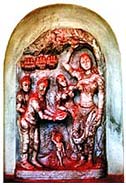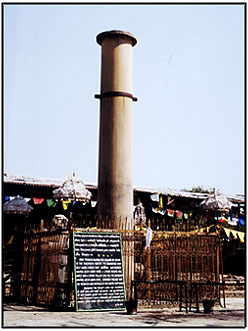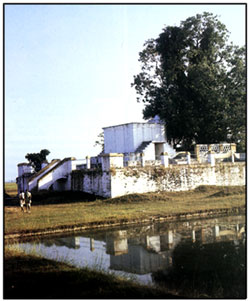 |
|
|
| |
||
| |
|
|
| |
||
|
|
||
| |
||
Lumbini is situated at the foothills of the Himalayas
in modern Nepal. In the Buddha's time, Lumbini was a beautiful
garden full of green and shady Sal trees (Shorea). The garden
and its tranquil environs were owned by both the Sha The bas relief above [ click to view ] depicts Maya Devi with her right hand holding on to a branch of a sal tree with a newborn child standing upright on a lotus petal, shedding an oval halo, around his head, while two celestial figures pour water and lotuses from vessels of heaven as indicated by the delineation of clouds. This nativity scene was installed by Malla Kings of the Naga dynasty from about the 11th to 15th Century in the Karnali zone of Nepal. In 249 BC, when the Emperor Ashoka visited Lumbini it was a flourishing village. Ashoka constructed four stupas and a stone pillar with a figure of a horse on top. The stone pillar bears an inscription which, in English translation, runs as follows: "King Piyadasi (Ashoka), beloved of devas, in the 20 year of the coronation, himself made a royal visit, Buddha Sakyamuni having been born here, a stone railing was built and a stone pillar erected to the Bhagavan having been born here, Lumbini village was taxed reduced and entitled to the eight part (only)". Maya Devi Temple
It is pointed out by scholars that the temple of Maya Devi was constructed over the foundations of more than one earlier temple or stupa, and that this temple was probably built on an Ashokan stupa itself. On the south of the Maya Devi temple there is the famous sacred bathing pool known as Puskarni. It is believed that Maha Devi took a bath in this pool before the delivery. By the side of the Ashoka pillar there is a river which flows southeast and is locally called the 'Ol' river. In 1996, an archaeological dig unearthed a "flawless stone" placed there by the Indian Emperor Ashoka in 249 BC to mark the precise location of the Buddha's birth more than 2,600 years ago, if authenticated, the find will put Lumbini even more prominently on the map for millions of religious pilgrims. Recently, several beautiful shrines have been built by devotees from Buddhist countries. A visit to Lumbini, the birthplace of Buddha, is not only for spiritual enlightenment but also for solace and satisfaction that one gets in such a calm and peaceful place. |
| |
|||||||
| |
|||||||
| |
Copyright © 2008 - BDEA Inc. & BuddhaNet. All rights reserved. | |
|
|
|
|
|
| |
|||||||
| |
|||||||

 kyas
and Kolias clans. King Suddhodana, father of Gautama Buddha
was of the Shakya dynasty belonging to the Kshatriya or the
warrior caste. Maya Devi, his mother, gave birth to the child
on her way to her parent's home in Devadaha while taking rest
in Lumbini under a sal tree in the month of May in the year
642 B.C. The beauty of Lumbini is described in Pali and Sanskrit
literature. Maya Devi it is said was spellbound to see the natural
grandeur of Lumbini. While she was standing, she felt labor
pains and catching hold of a drooping branch of a Sal tree,
the baby, the future Buddha, was born.
kyas
and Kolias clans. King Suddhodana, father of Gautama Buddha
was of the Shakya dynasty belonging to the Kshatriya or the
warrior caste. Maya Devi, his mother, gave birth to the child
on her way to her parent's home in Devadaha while taking rest
in Lumbini under a sal tree in the month of May in the year
642 B.C. The beauty of Lumbini is described in Pali and Sanskrit
literature. Maya Devi it is said was spellbound to see the natural
grandeur of Lumbini. While she was standing, she felt labor
pains and catching hold of a drooping branch of a Sal tree,
the baby, the future Buddha, was born.  Lumbini
remained neglected for centuries. In 1895, Feuhrer, a famous German
archaeologist, discovered the great pillar while wandering about
the foothills of the Churia range. Further exploration and excavation
of the surrounding area revealed the existence of a brick temple
and a sandstone sculpture within the temple itself which depicts
the scenes of the Buddha's birth.
Lumbini
remained neglected for centuries. In 1895, Feuhrer, a famous German
archaeologist, discovered the great pillar while wandering about
the foothills of the Churia range. Further exploration and excavation
of the surrounding area revealed the existence of a brick temple
and a sandstone sculpture within the temple itself which depicts
the scenes of the Buddha's birth.